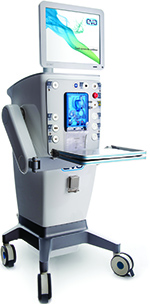 |
Dr. Shah, who discloses that he is an advisory board member for Dutch Ophthalmic Research Center (DORC), the maker and distributor of EVA, has performed around 50 vitrectomies with EVA. Its VacuFlow VTI (for valve timing intelligence) pump system provides both flow and vacuum fluidics.
Fast Cutting, Even Suction
For Dr. Shah, the TDC cutting system, which stands for two-dimensional cutting, is well suited to the smaller-port 27-gauge surgery that more retina specialists are adopting. The TDC vitrectrome cuts at speeds of up to 16,000 cycles per minute and has vacuum control that maintains even suction.“With this technology you can do flow control that allows precision control with less movement of the retina, which is especially evident during retinal detachment,” Dr. Shah says. “In flow control, the flow pushes individual pieces into the cutter; it gives you precision and you have to go to it, it doesn’t come to you.”
Flow control provides a higher level of accuracy when cutting the vitreous close to the retina surface. “That allows you to do very meticulous, precise shaving of the vitreous base,” he says. The TDC vitrectrome also cuts forward and backward without closing, Dr. Shah says. “This is a very different cutter.”
Flow and Vacuum Modes
The ability to change between flow and vacuum modes also has its advantages, as Dr. Shah explains. “If you want to do entire case in vacuum you can. If you want to do an entire case in in flow, you can, or you can do a combination,” he says. “Typically, I do a core vitrectomy with vacuum mode and then as I move into the periphery, I will do that in flow mode.”The system does allow faster operative times. “But to me that’s really not relevant whether it’s three or five minutes less,” Dr. Shah says. “We all want to look at outcomes of patients as more important than times.”




